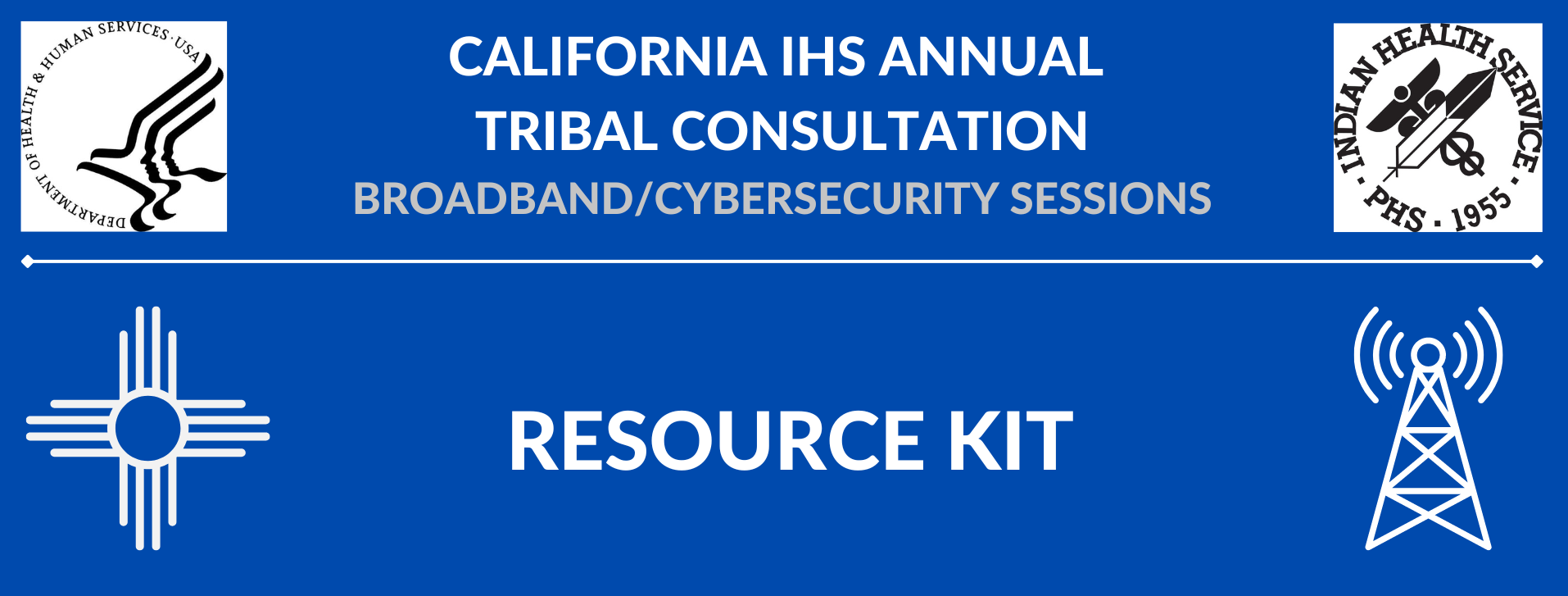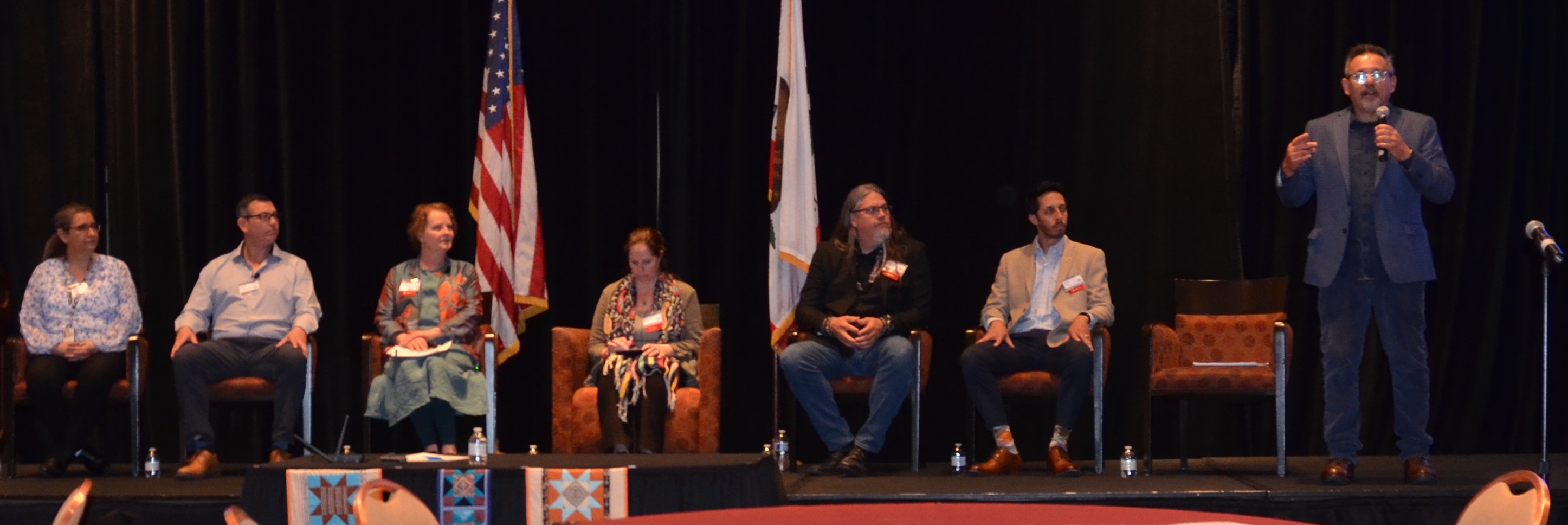Broadband & Cybersecurity - Resource Kit

Hello!
The technology staff at the California Area Office of the Indian Health Service thanks you for joining us at the Agua Caliente Resort in Rancho Mirage for our Tribal Consultation Broadband/Cybersecurity Sessions. As promised, we have some digital swag: we’ve put together a resource kit for those of you who would like to get started on on the broadband journey. Included in this document are Takeaways (informed by our expert panelist suggestions for what you need to know to take advantage of emerging broadband opportunities), as well as map, funding and contact information.

Broadband Takeaways
Our esteemed panelists were asked to submit what they thought were the most important things to consider as you endeavor to take advantage of emerging broadband opportunities. We included their contributions in this list.
Understand the landscape
Have you identified locations that need service? Have you identified your anchor institutions? In addition to identifying needs and challenges, Tribes should be gathering mapping data that will assist in the planning process from existing homes, roads, utilities, and most importantly rights-of-way and permitting.
 Are there hospitals, schools or other institutions that may be beneficiaries of broadband service? If you’ll be standing up a tribal service provider, consider these anchor institutions potential customers as well as potential partners and participating stakeholders.
Are there hospitals, schools or other institutions that may be beneficiaries of broadband service? If you’ll be standing up a tribal service provider, consider these anchor institutions potential customers as well as potential partners and participating stakeholders.
Identify your needs
Understand the needs and challenges of your community with respect to broadband, but more specifically education, health, and employment. Tribes should be in a position to quantify what their needs and challenges are to funding agencies and potential partners.
Inventory your assets
Is there existing infrastructure that could be folded into this effort? Assets may include property that is optimal for tower placement. In the case of one tribe, local initiatives to build a tribal computer learning center and develop online content in support of digital sovereignty were used as the match in a Department of Commerce grant, thus funding the construction of a 400 foot communications tower on which the tribe is generating income by leasing space.
Identify your stakeholders
A Tribal broadband project will benefit from the inclusion of a wide range of stakeholders who will be impacted and/or benefit. Consider folding into the initiation process representatives from the county, as well local utilities, schools and other anchor institutions. This will help you identify barriers and find consensus.
Identify your champions
Who is on the team leading the broadband work within your community? Are your information technology, public works, community development and/or natural resources people involved? Do you have relationships with other Tribes who may share their experience, or - if geographically near - be willing to co-sponsor a broadband project? Make sure the voices of those in the community with the greatest need are also your greatest advocates.
Resources
What organizations and agencies are offering funding? How are you participating? Are you familiar with the resources that have been made available within the Tribal Broadband Connectivity Program (TBCP) section of the BroadbandUSA website? Tribes should be engaging at a state and local level to leverage all opportunities from planning to deployment. Additionally, Tribes should be engaging with their state Broadband Equity Access and Development (BEAD) and Digital Equity Federal Program Officers (FPO) and their regional Tribal FPO to ensure open lines of communication. Don’t let opportunity pass you by…there are many deadlines and a lot of funding for development support.
have been made available within the Tribal Broadband Connectivity Program (TBCP) section of the BroadbandUSA website? Tribes should be engaging at a state and local level to leverage all opportunities from planning to deployment. Additionally, Tribes should be engaging with their state Broadband Equity Access and Development (BEAD) and Digital Equity Federal Program Officers (FPO) and their regional Tribal FPO to ensure open lines of communication. Don’t let opportunity pass you by…there are many deadlines and a lot of funding for development support.
IMPORTANT RESOURCE: The California Public Utilities Commission (CPUC) has a great wealth of information, and a central page that serves as a compendium. If you do nothing else, bookmark this page:
Plan - build or buy?
Think about your tribe’s “digital sovereignty”. Should you come away from this owning the infrastructure?
Consider that some components age better than others. A communications tower in one decade looks pretty much like a communications tower in the preceding decade. The same cannot be said of technical components such as a point to point system for signal relay. Is it best to own a tower and lease equipment, lease space to other entities who provide that equipment, or offload ownership of the tower to an external entity?
Governance and structure
The concept of “dig once” conveys that each time a trench is opened on tribal land - for whatever purpose - the opportunity is taken to fill it with conduit for fiber optic cable, configured with ingress and egress points for later fiber installation. If tribal land is contiguous, is it possible to establish an ordinance that assures this? In the case of “checkerboard” (non-contiguous) reservations this may be more difficult. If it isn’t feasible or appropriate to mandate that a non-tribal utility adhere to this edict, it may be possible to fold them in as stakeholders and establish “buy-in”. At the least, your Tribal Council should consider passing a resolution that establishes “dig once” as an intent. Assure that any trenching conducted on tribal land by tribal entities includes the laying of conduit.
Are you developing a new entity within your tribal organization, or are you using an existing business that currently provides utility services, such as water or roads? Do you have or know contractors that you can trust for advice about business planning or infrastructure building? Do you have this experience already within the tribal community?
Are you thinking about long-term sustainability and growth? For example, if you own a tower, you can not only build out broadband for your community, but you can generate revenue for your community by leasing space on it.
These topics are rich for exploration. Stay engaged with the organizations represented by our panel of experts. Contact info can be found at the bottom of this page.
MAPS
|
To know how to proceed with broadband development, we need to know where we are. A valuable resource is the California Interactive Broadband Map. Using the filters and layers of this tool you can view your area from the perspective of broadband adoption, broadband availability, applicable grants and much more. Under the Political Boundaries section click on "Tribal Lands” to further filter your view. Also of interest to Tribes may be the California Middle Mile Broadband Initiative. From the California Department of Technology Middle Mile website: “The middle-mile is the physical fiber optic infrastructure needed to enable internet connectivity. It is made up of high-capacity fiber lines that carry large amounts of data at high speeds over long distances. An open-access network gives providers and entities access to broadband infrastructure that will allow any networks to connect on equal economic and service terms.” The bottom map was shown at the Annual Tribal Consultation by Matt Rantanen. It describes the CENIC Middle-Mile Network. CENIC (“Corporation for Education Network Initiatives in California”) created the California Middle-Mile Broadband Initiative, LLC DBA “GOLDENSTATENET”. It is overseen by CDT. Click here or on the bottom map to view a detailed version. |
Funding
Important deadlines are imminent. Here are a few resources for broadband funding:
California Public Utilities Commission (CPUC)
The Federal Funding Account Applicant Tool will allow prospective applicants to examine service needs, highlight census blocks, and see estimated subsidies for potential projects – and then submit them as the first step of a grant application. Make sure to select “Tribal - A recognized Tribe or Tribally Owned Organization” in the dropdown.
Another important CPUC opportunity is the Broadband Technical Assistance program. More information regarding these programs can be found here.
National Telecommunications and Information Administration (NTIA)
The NTIA has multiple funding programs, including the Broadband, Equity, Access & Deployment Program (BEAD); Enabling Middle Mile Broadband Infrastructure Program; Tribal Broadband Connectivity Program; Digital Equity Act Programs; Broadband Infrastructure Program (BIP); and Connecting Minority Communities (CMC) Program.
Information regarding these funding opportunities can be found here.
California Advanced Services Fund (CASF)
The California Advanced Services Fund offers these opportunities:
- The CASF Adoption Account - Broadband Access Projects
Publicly available or after-school broadband access projects may include free broadband access in community training rooms or other public spaces, such as local government centers, senior citizen centers, schools, public libraries, nonprofit organizations, and community-based organizations. It may also include funding community outreach, such as analysis, comparison of Internet plans with the community, and call centers that will increase broadband access and adoption. Application cycle deadlines:
- June 1, 2023
- January 1, 2024
- July 1, 2024
Grants to subsidize the cost of middle-mile and last-mile infrastructure to expand the State’s broadband network. The Annual Deadline for Broadband Infrastructure Grant Project Proposals for 2023 has been changed from May 1st to June 1st.
Information regarding these funding opportunities can be found here.
Thank you again for your interest in our topics. Below is contact information for the presenters at the 2023 California IHS Annual Tribal Consultation. The presentations for Karen Eckersley, Andrew Orosco, and Reese Weber; The Tribal Broadband Planning Toolkit; a larger representation of the Middle-Mile map; and the CENIC Building a Statewide Middle-Mile Network Series document can be found here.
__________________________________________________________
Contacts
Matt Rantanen
Vice President, Tribal Broadband
CENIC California Middle-Mile Broadband Initiative, LLC Golden State Network
matt.rantanen@goldenstatenet.org
760.207.1303
Karen Eckersley
Communications Division
California Public Utilities Commission
karen.eckersley@cpuc.ca.gov
415.471.8561
Ken Holbrook
Tribal Advisor
California Public Utilities Commission
kenneth.holbrook@cpuc.ca.gov
415.703.2782
Andrew Orozco
Broadband Program Specialist
Tribal Connectivity and Nation-to-Nation Coordination
Office of Internet Connectivity and Growth (OICG)
National Telecommunications and Information Administration (NTIA)
U.S. Department of Commerce
aorosco@ntia.gov
(202)494-4209
Robert Gemmell
CAIHS CIO, Associate Director
robert.gemmell@ihs.gov
916.930.3981 x326
Kelly Stephenson
CAIHS Deputy CIO, Telecommunications Liaison
kelly.stephenson@ihs.gov
916.930.3981 x330
Reese Weber
CAIHS Chief Information Security Officer
theresa.weber@ihs.gov
916.930.3981 x307
We offer a special thank you to Commissioner Darcie L. Houck of the California Public Utilities Commission for her presence and contribution to the CAIHS Tribal Broadband Session.


 California Area Office
California Area Office

